by Catherine E. Park
Three days from the snows of Minneapolis, with overnight stops at Chillicothe, Mo., Conway, Arkansas, and 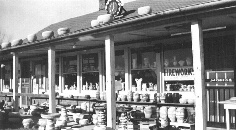 Baton Rouge, La., we found a world of sunny spring-like weather. The last of the snow had been left behind as we topped the crest of the rolling Ozark country in Arkansas. There deep winding gulches, one picturesquely named Dogwood Gulch, lay sprawled irregularly away from the highway to the hummocky horizon. "Shepherd of the Hills" country, one sign called [it]. Pottery and gift shops were strung along our road, mostly featuring objects in brilliant blue.
Baton Rouge, La., we found a world of sunny spring-like weather. The last of the snow had been left behind as we topped the crest of the rolling Ozark country in Arkansas. There deep winding gulches, one picturesquely named Dogwood Gulch, lay sprawled irregularly away from the highway to the hummocky horizon. "Shepherd of the Hills" country, one sign called [it]. Pottery and gift shops were strung along our road, mostly featuring objects in brilliant blue.
The toll bridge over the Mississippi River at Vicksburg, 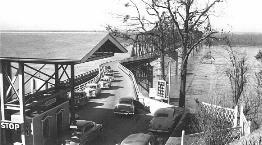 city of monuments, brought us into the state of Mississippi
with its yucca, occasional palms, Spanish moss, and miles of flat cottonland. Our brief stay in Vicksburg featured turtle soup and pralines at the famous Tuminello's Kitchen.
city of monuments, brought us into the state of Mississippi
with its yucca, occasional palms, Spanish moss, and miles of flat cottonland. Our brief stay in Vicksburg featured turtle soup and pralines at the famous Tuminello's Kitchen.
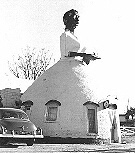 After Natchez where we photographed a startling but dilapidated statute of Mammy, at Mammy's Cupboard, we were once more in La. And bound for Baton Rouge, the capital city. Here we spend most of Christmas Sunday, and were among the many visitors at morning service in First Methodist Church. This church's choir under Mr. Holler, though including only 5 other men, produced a surprising amount of volume for their numbers, with the harmony in excellent balance. Many pots of poinsettia beautified the church. In fact, Christmas decorations abounded wherever we went, and by night every town glowed with myriads of coloured lights. Many a town or home had its lighted creche, draped with cedar, palmetto, or even in one case Spanish moss.
After Natchez where we photographed a startling but dilapidated statute of Mammy, at Mammy's Cupboard, we were once more in La. And bound for Baton Rouge, the capital city. Here we spend most of Christmas Sunday, and were among the many visitors at morning service in First Methodist Church. This church's choir under Mr. Holler, though including only 5 other men, produced a surprising amount of volume for their numbers, with the harmony in excellent balance. Many pots of poinsettia beautified the church. In fact, Christmas decorations abounded wherever we went, and by night every town glowed with myriads of coloured lights. Many a town or home had its lighted creche, draped with cedar, palmetto, or even in one case Spanish moss. 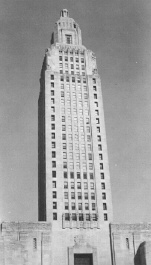
Sunday afternoon we inspected the beautiful $5,000,000 Capital and grounds, with Governor H. P. Long's tomb in the centre of the gardens, and viewed the countryside from the lofty look-out platform, 27 floors up. What we saw was the magnificent, sweeping curves of the Mississippi R., flanked by acres of city and more acres of oil storage tanks for one of the world's largest oil refineries. The gardens below us looked like a picture on a carpet, the cars like kiddies' toys creeping about, and the broad drives each with its three rows of diagonal parking spots marked with painted lines, looked like strips of gray cloth decorated with a darker herringbone design. The interior of the Capital is adorned with 34 different kinds of marble, beautiful statuary, and fabulous brass plated doors showing scores of historical scenes and figures sculptured on the brass. France's gifts to Louisiana, two immense vases of Sèvres china, stand on marble pedestals in the main entry room of the Capitol, and between the vases, opposite the front door, are hung all ten flags which have at various times in its long and varied history flown over Louisiana. Here they are: (1) the Spanish flag of Leon and Castile which was carried by Columbus and De Soto in their early explorations (2) the flag of Bourbon Spain (3) the Fleur de Lys banner of France showing three golden lilies on a white ground, raised by explorer La Salle, (4) the French tri-color flag of Napoleon's time (5) the British Union Jack (less St. Patrick's cross) which was raised after Britain's purchase of Louisiana from France (6) the one star of W. Florida, a white star on a blue ground, which was Louisiana's flag for the 62 days it was part of the independent state of W. Florida, (7) Louisiana's flag during her own brief independence, (8) the flag of the Confederate States used during Confederacy independence days (the Confederate battle flag was also used during the Civil War but not exclusively) (9) the State banner with its emblem, the pelican, and (10) the present National flag of U.S.A. The Confederate battle flag and the early national flag showing 15 stars and 15 stripes were added for good measure. 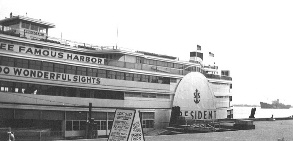
South of Baton Rouge came the sugar cane country, flat and wet, then New Orleans in all her Christmas finery. We didn't see the harbour despite glaring invitations to take the sight-seeing boat trip on the S. S. President, a capacious side-wheeler. However, we saw all we could of the Vieux Carré or the Old French Quarter by walking through it for 5 or 6 hours. Royal St., in Vieux Carré, is famous for its antique shops where we browsed and window-shopped to our heat's content. The shops themselves were antiques, with their lacy ironwork decorations and their 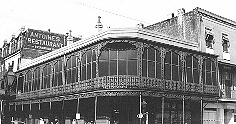 many-pillared fronts which sometimes formed an arcade half a block or a block long over the side-walk. Many had picturesque interior courts used as restaurants or giving access to more shops. Jackson Square, complete with bronze equestrian statue of Gen. Andrew Jackson, grass, trees, slave-built apartment houses and side-walk artists, was included in our walking tour. We also spent some minutes in lovely St. Louis Cathedral which fronts on this square. Elsewhere in the city we snapped enormous piles of clam shells (used in road-building) along the Industrial Canal which cuts through one edge of New Orleans. St. Louis Cemetery with its many, many above ground tombs of marble, granite, concrete, or brick was a most unusual sight. Epitaphs in French or Spanish or English appeared there, some on tombstones dating back nearly 100 years. Audubon Park, Central Park and its museum (where the donor seemed to get more publicity than the donated object of art) and Tulane University with its famous Sugar Bowl Stadium came in for some attention too.
many-pillared fronts which sometimes formed an arcade half a block or a block long over the side-walk. Many had picturesque interior courts used as restaurants or giving access to more shops. Jackson Square, complete with bronze equestrian statue of Gen. Andrew Jackson, grass, trees, slave-built apartment houses and side-walk artists, was included in our walking tour. We also spent some minutes in lovely St. Louis Cathedral which fronts on this square. Elsewhere in the city we snapped enormous piles of clam shells (used in road-building) along the Industrial Canal which cuts through one edge of New Orleans. St. Louis Cemetery with its many, many above ground tombs of marble, granite, concrete, or brick was a most unusual sight. Epitaphs in French or Spanish or English appeared there, some on tombstones dating back nearly 100 years. Audubon Park, Central Park and its museum (where the donor seemed to get more publicity than the donated object of art) and Tulane University with its famous Sugar Bowl Stadium came in for some attention too.
Christmas Day began with a bang - about 4:00 a.m. In fact, since fireworks are a traditional part of the Yule-tide festivities in Louisiana, we were hearing bangs from the day before Christmas until many days after it. We left New Orleans that day, driving through the negro part of town where many happy youngsters were trying out shiny new Christmas roller skates. Christmas decorations appeared sometimes even in pitiful little shacks and hovels. We noted one group of coloured people just leaving their plain little wooden church after Christmas morning service. Some of the churches were in very poor condition, tumble-down old wrecks, as seen from outside at any rate, but many of the homes were no better.
After a look at the Gulf of Mexico we headed back for warmer inland areas, passing a score or more cane mills and many other signs of the sugar industry, on the way to Lafayette, La.  On Christmas we came upon a modern "knight-of-the-road" in his tiny covered wagon drawn by two mules. A third mule and two goats were lagging along, tethered to the wagon, while a little white dog lay on the back of one of the harnessed mules. Signs on the wagon said: "Yep, take pictures!" and "Here comes Orville." He had, he claimed, come from Colorado and was aiming for Florida, but he probably wasn't averaging more than 20 or 25 leisurely miles per day. Yes, we took his picture. He even wanted to have "your momma" in it.
On Christmas we came upon a modern "knight-of-the-road" in his tiny covered wagon drawn by two mules. A third mule and two goats were lagging along, tethered to the wagon, while a little white dog lay on the back of one of the harnessed mules. Signs on the wagon said: "Yep, take pictures!" and "Here comes Orville." He had, he claimed, come from Colorado and was aiming for Florida, but he probably wasn't averaging more than 20 or 25 leisurely miles per day. Yes, we took his picture. He even wanted to have "your momma" in it. 
Morgan City's shrimp fleet made a Christmas Day subject for our camera. One fishing boat hauled into the town's main street for Christmas had Santa on board, gift packages in the fish-nets slung to dry, and even Rudolph the red-nosed reindeer out in front on a moss-draped platform, hitched to the prow of the little ship, the "Spirit of Morgan City," as it was named.
Another pair of snapshots on that balmy day show Wilford or me, coatless, in front of an thriving bamboo hedge.
In Lafayette, our headquarters for several days was at Plantation Court, where the main building was designed to look like one of the old-time French mansions, with brick first floor, frame second floor, and a steep cottage-style roof flattening out to a lesser pitch 3 or 4 yards from its spreading eaves. Blooming camellia bushes and little pine trees made a charming setting for the 15 or more guest units at this motel. Our hospitable host cut me a camellia to paint and I had it for 6 days. 
Faring forth from Plantation Court we saw Lafayette's beautiful cathedral, named for St. John and depicting many scenes from his life in its stained glass windows; the magnificent cathedral oak with its 150-foot spread of branches sheltering a semi-circular garden with statue and half the church lawn besides; another old-style cemetery; the local seat of learning (S.L.I.) and some famous old homes with their quiet and gracious charm. Another day we visited the Longfellow Evangeline State Park where Acadian history is preserved in the museum and an Acadian-style house used as a gift shop. A tomb surmounted  by a lovely bronze statue of Evangeline is to be found beside an ancient church in the village of St. Martinville nearby. This is the last resting place of the ill-fated Emmeline Labiche, the original of Longfellow's tragic heroine. An oak beside Bayou Teche where she is supposed to have met her faithless Gabriel is called Evangeline Oak. Near the park museum another has been name the "Gabriel Oak". St. Martinville also boasts a unique P.O., housed in a restored old-style mansion which still has its original fancy ironwork. Not far out of town is the Oak and Pine Alley, an avenue of trees set out over 100 years ago by slave labor, and now forming a continuous tunnel of shade for more than 1¼ miles.
by a lovely bronze statue of Evangeline is to be found beside an ancient church in the village of St. Martinville nearby. This is the last resting place of the ill-fated Emmeline Labiche, the original of Longfellow's tragic heroine. An oak beside Bayou Teche where she is supposed to have met her faithless Gabriel is called Evangeline Oak. Near the park museum another has been name the "Gabriel Oak". St. Martinville also boasts a unique P.O., housed in a restored old-style mansion which still has its original fancy ironwork. Not far out of town is the Oak and Pine Alley, an avenue of trees set out over 100 years ago by slave labor, and now forming a continuous tunnel of shade for more than 1¼ miles.
New Year's Day, 1952, climaxed a leisurely week at Plantation Court. The weather had turned as warm as summer, over 76°, but our sun-bathing was interrupted by large white clouds which kept rolling and swirling into the path of the sun. We therefore spent most of the afternoon at the Avery Island Jungle Gardens where camellias, dense groves of bamboo, and giant moss-draped oaks beautified a large park-like area which included a bird sanctuary. We saw ducks, swans, Canada geese, blue heron, and egrets, or white heron as well as smaller birds which hid too quickly for certain identification. We admired the sunken gardens, the many shady cement-block paths, the bayou drive, and the Bhudda. This large gilded wooden idol represented a man sitting cross-legged on a large open lotus-lily. The heavy-lidded eyes and full-curving lips of the image probably portrayed the sculptor's idea of oriental beauty. The Bhudda was made originally for a temple near Peking, fell prey to looting bandits and was finally sold in America to the owner of Avery Island. It is now housed in a tiny tile-floored, tile-roofed temple with glass walls and concrete supporting pillars made to look like cluster of 2-inch thick bamboo poles. The wood work is painted bright orange and the roof tiling a bright dark blue. The temple is up on a tiny terraced hill, every (step of the) terrace having a bed of narcissus rising against the wall of earth or stone above. The hill overlooks an ornamental pool with a small stone bridge arching across it, and trees and flowers almost surround the temple. An artistic setting for a beautiful old statue, with due respect to the religious significance it once held for its intended worshipers. Avery I. has its salt mine and oil wells, but the gardens are its chief attraction. Before leaving we watched hundreds of egrets and heron flocking to roost over the lake in Bird City. The favourite perches for the white egrets seemed to be the trees standing in the water, while the blue heron were mostly on long branch-covered racks built about four feet above the water. The next morning we read about the Sugar Bowl game in the New Orleans paper.
January 2nd saw us heading for home, stopping for a sun-bath or to be shown through a camellia garden by a soft-spoken coloured man. The sweet potato country, which features a yambilee each year at the town of Opelouas, was soon left behind and we traveled through miles of pine forests to Ruston, home of the forest festival. By that time it was Jan. 3rd and raining steadily, making all the red earth sections take on the colour of cooked yams (or redder still) and all the rushing, overflowing creeks and rivers look like creamed coffee. In Arkansas came less wooded, rolling country, glowing even in that rainy light, with more orange earth and fields of orange broom. As we climbed the Ozarks we reached an altitude where freezing rain had coated everything with heavy glittering ice. Fortunately the raod was bare, but trees and bushes were bending to the ground, while telephone and fence wires wore the most perfect and longest fringes of icicles which I have ever seen.
We stopped for a souvenir in the Shepherd of the Hills country and Wilford chatted in the gift shop with people from Osage, Iowa, who were heading south to summer while we were returning to home and winter. We were in Missouri for overnight and encountered considerable highway ice all through that state. Iowa was better, and after our last night on the orad (near Des Moines, Ia.) we continued with near perfect road conditions all the way to Minneapolis.
Thus, on Jan. 6th, in brilliant winter sunshine and near 0 temperatures we returned once more to our home, sweet home. It felt good to be back in Minnesota after looking at unfamiliar landscapes for several weeks, and of course Minneapolis was a welcome sight. After all, there's no place like home.